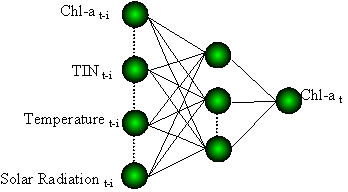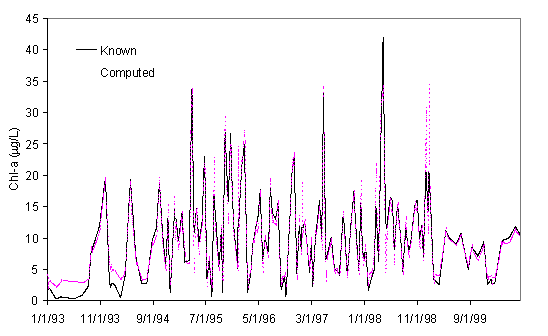Dynamics of Algal Blooms and Red Tides in Coastal Waters:
Monitoring, Modelling and Prediction
¡@
Data-Driven Modelling of Coastal Algal Blooms (Poster)
¡@
¡@¡@
Introduction
¡@
The modelling of algal bloom dynamics remains an extremely difficult problem. In particular, the development of a practical forecasting and early warning system is hampered by the uncertainty in the pacification of many kinetic coefficients used in the deterministic, process-based water quality models. The objective of this work is to develop, based on existing validated process-based water quality models, data-driven and data-assimilative techniques for operational algal dynamics forecasting and water quality control.
Artificial Neural Networks
(ANN)
In recent years there has
been a growing tendency to use data-driven approaches such as Artificial
Neural Networks (ANN) to complement or even replace deterministic
knowledge-based models. The use of ANN is particularly useful when
-
the physical world is not fully defined
-
the model has many uncertainties (model coefficients and/or input parameters)
-
there is extensive data for training the network.
This is essentially a nonlinear 'black-box' approach, which assumes a set of prescribed intermediate relations that enables the output(s) to be predicted from a number of input parameters. The parameters of these relations (the network) can be obtained by `training' the network using past data; the success of the prediction is then tested against future data. The application of neural network techniques to study algal blooms has recently been attempted; however, the great majority of the work is concerned with limnological or riverine applications. The study of its use for predicting algal blooms in coastal waters has not been reported.
¡@

Backpropagation learning Network Structure
The subtitle t-i indicates the time lag of i days prior of the forecast time t, which is up to 7 days.
¡@
Biweekly water quality data (1982-1999) for the weakly-flushed Tolo Harbour, known for its frequent algal bloom occurrences, is chosen for analysis. The algal dynamics is represented by the variation of the concentration of Chlorophyll a (Chl-a). The network inputs include time-lagged Chl-a, total inorganic nitrogen (TIN), water temperature, solar radiation, and other environmental variables affecting algal growth. A 3-layer feedforward network structure is employed.
¡@
Results
The results show that ANN can be an alternative for predicting long-term
trends of algal dynamics in Tolo Harbour. The ANN prediction follows the
observed trends quite well for both the training and testing periods.
Unlike previous studies, the quality of the prediction is mainly
dependent on the time-lagged Chlorophyll-a and quite insensitive
to the inclusion of TIN and other environmental variables. This appears
to suggest an auto-regressive type of process and that nutrients are
typically not limiting in the eutrophic bay.
Despite the good agreement with data on long-term trends, the neural network approach cannot be relied upon to give short-term algal bloom predictions (of the order of a week).

ANN testing result at Tolo Harbour, Chl-a at station TM4
¡@
¡@